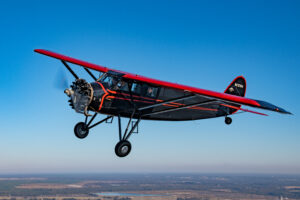Project Description

MPH
SEATS
Stinson Junior S
Role: Single Pilot, Three Passenger Aircraft
National Origin: United States
Manufacturer: Stinson
First Flight: 1931
Number Built: 100
The four seat Stinson “Junior” model S for 1931-32 was but very little changed from the SM-8 of 1930, but it was loaded with little improvements. Comparatively speaking, the SM-8 “Junior” was a very good airplane, a terrific bargain, and was selling like hot-cakes. Already popular with men of business, the flying-service operator and the family-man who flew for the sport, the “Junior” in the new S-version took on some added chores now to prove its terrific utility. The “New S” was the so-called Stinson “Air Taxi” and charter-the so-called Stinson “Air Taxi” and charter-flight operators were scattered in all parts of the country. Unusual for an airplane of this modest size, the “Model S” even took on the role of air-liner. Several small airlines sprang up in the most likely and unlikely spots to offer scheduled and non-scheduled runs, most often to connect passengers with main-line systems. Without a doubt the best buy in the country for a four-place cabin airplane at this time, sales for the new “Junior S” held up well in spite of the steadily sinking economy.
The Stinson Junior-type “model S” was a high-winged cabin monoplane with seating arranged for four, all in an environment that was pleasantly comfortable, practical, and quite serviceable. One would think that an airplane of this type with a price-tag of less than $5000 would surely have to sacrifice something for the sake of economy, but this certainly was not true of the new “Stinson S”. Features of convenience and finery, as introduced in this basic “Junior” design a year previous, were all retained in full with perhaps a little more stress on being more serviceable and more practical.
Powered with the popular 9 cyl. Lycoming R-680 engine of 215 h.p., the new “S” delivered a very good performance and certainly was not choosy about its chore or base of operations; a short sod-strip or a long paved runway, it mattered little to this amiable craft. Slanted toward businessmen and private owners, as well as the flying service operators, this airplane was purposely designed as a strong, safe, and easy to fly airplane. Of very good nature, the “Junior S” like its earlier sister-ships, was very patient and made great allowances for abuse or error. The enviable safety record and the interesting, almost unbelieveable lore left behind by the Stinson “Junior” type was not shared by too many other airplanes. The type certificate number for the Stinson “Model S” was issued 5-12-31 and at least 100 examples of this model were manufactured by the Stinson Aircraft Corp. at Wayne, Michigan, a division of the Cord Corp.
NC12164 was restored by Gregory “Bunky” Larson of Washington. The museum purchased the Junior S from the Larson estate and it joined the collection in 2020.
General characteristics
- Crew: 1
- Capacity: 3 pax
- Length: 28 ft 11 in
- Wingspan: 42 ft 1 in
- Height: 8 ft 9 in
- Wing area: 235 sq ft
- Powerplant: 1 × Lycoming R680 air-cooled radial piston engine, 300 hp
- Propellers: 2-bladed control-able pitch propeller
- Empty weight: 2,172 lb
- Gross weight: 3,265 lb
Performance
- Maximum speed: 120 mph
- Cruise speed: 100 mph
- Range: 400 mi
- Service ceiling: 11,000 ft